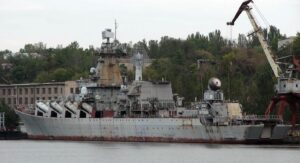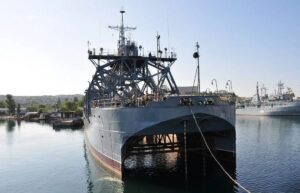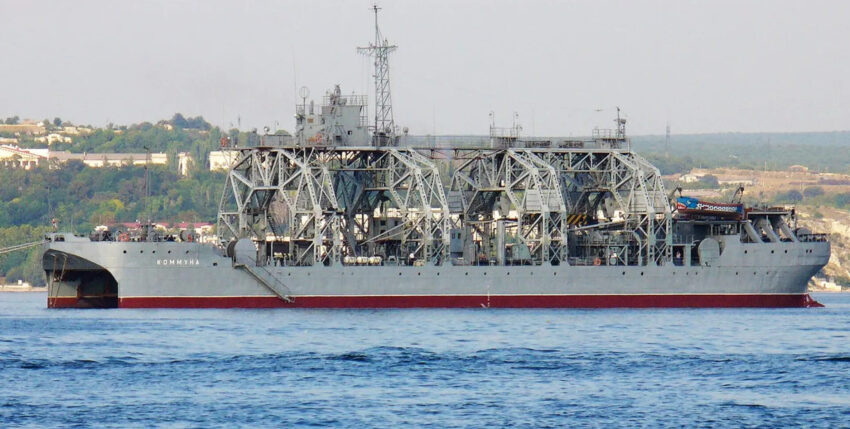As far as the loss of life is concerned, the Kremlin continues to remain silent; at best there is a hesitant admission of figures that are in any case completely understated.
Uncontrolled revelatory tweet
Interesting in this context is a tweet from a Moscow source close to the government dated Friday, 22 April 2022, which was only given a minimal lifespan before disappearing from the scene. The tweet stated the number of casualties and missing persons from the war in Ukraine, which, however, corresponded to the somewhat inflated figures published by Ukrainskaya Pravda (https://www.pravda.com.ua/eng/) with 23,000 dead Russian soldiers: 13,400 dead, 7,000 missing, 116 dead on the "Moskva". Officially, the figure of 2,000 killed on the Russian side is still valid - but no one but one really believes that anymore!
...stayed at sea ...
After initially announcing the loss of the guided missile cruiser "Moskva" that all crew members had been rescued from on board, Moscow officially announced on 20 April that there had been one death and 27 missing - 396 soldiers had been evacuated. What is surprising about these figures is that according to documentation, this cruiser was supposed to have a crew of around 480 - one source even speaks of a crew of well over 600 - and in wartime, as you would expect, a ship like this would never leave the harbour understaffed!
No conscripts - no reservists
Meanwhile, an independent Russian information portal spoke of 37 dead marines, including conscripts, who (since 2017) should not actually be serving on board warships, let alone be on a war mission - but after all, according to Russian interpretation, it is not a war! And as recently as the beginning of March, the President assured his fellow Russians that neither reservists nor conscripts were taking part in the "special operation". However, more and more people are coming forward in the search for information about their "missing" relatives and sadly make the figure of over 100 victims of the sinking of the "Moskva" appear realistic. It is a well-known fact that the veil that Moscow draws over its own losses is very impenetrable and extremely stubborn.
Injured? Which injured?
Tragically, there has not even been a mention of injuries, which always occur to a not inconsiderable extent in such incidents!
Of names and meanings
Heavy missile cruiser "Moskva" of the "Slava" class - the two names alone are significant! "Moscow" as the capital of Russia and "Glory", or "Honour", are heavyweight, emotional and pregnant with symbolism in a military and power-political context. Not far from the place where the Ukrainian navy recently sank its flagship "Hetman Sagaidachny" in Mykolaiv, the cruiser "Slava" was launched at the end of July 1979 after being christened as a type ship of the "Atlant" class (Project 1164) and was commissioned on the last day of 1982. It was to be a series of six units, but only four were launched and only three were equipped for service. After "Slava", "Marshal Ustinov" and "Varyag", however, the "Ukrayina" was never completed and is still lying abandoned as a hulk on the pier on the south bank of the Inhul River in the former Nikolayev-Nord shipyard north of the city centre (24 Naberezhna Street).

Flying name change
In 1996, the Russian Navy decided to give the "Slava" the name of the Russian capital as the flagship of the Black Sea Fleet. As a "part" of Russia, it was to symbolically lead the fleet or lie in the port of Sevastopol, just as the unspeakable separation process between Ukraine and Russia was in difficult waters in Crimea (see "Sevastopol and the Black Sea Fleet" from 17 March 2022). This was followed by a quarter of a century of the "Moskva" as the Russian top dog in the Black Sea - including modernisation and a long laytime in the shipyard.
Last act
Then, with the opening of the war, the appearance of the "Moskva" off the small Ukrainian Snake Island as a show of force during the conquest - and now the sinking of the Russian flagship by Ukrainian anti-ship missiles despite triple-stacked air defence systems on the cruiser. Both the ship and the anti-ship missiles were not of the very latest design: the ship was built before the first missile battles (Falklands) were recognised, and the missiles were based on Soviet designs and approached in the subsonic range. In addition, moments of surprise on the one hand and signs of wear and tear on the other, possibly deceptive manoeuvres on the Ukrainian side and a chain of unfortunate circumstances on the Russian side. There is already a lot of speculation about this, but those who were really there won't be talking for the time being! The ship is now lying on shallow, easily accessible ground at a depth of 50 rather than 100 metres and awaits its fate.
A veteran steps into the spotlight
The honourable task of the keeper of the dead will now probably fall to the underwater salvage and rescue ship "Kommuna", one of the oldest ships in the world with 110 years under its twin keel. Commissioned in 1915 as the "Volkhov" in the service of the Baltic Fleet during the Tsarist era, the catamaran-shaped submarine tender also served as a salvage vessel for the Imperial Navy, the Soviet Navy and now the Navy of the Russian Federation. In this way, it has - so far - survived two world wars, and that's how it should stay!
Old ship with a new task
After the revolution, the unusual-looking ship was renamed "Kommuna" in honour of the long-gone French revolutionaries. During her time in service, she brought everything from the bottom back to the surface that could be reached - from submarines and aeroplanes to motor vehicles from on board a sunken supply ship during the siege of Leningrad in the Second World War. Due to the ever-increasing size of nuclear submarines, she remained too small for the direct salvage business, so after a "modernisation" in 1967 she joined the Black Sea Fleet, where there were only small conventional boats anyway. Still in operation today, she is a universal platform for diving rescue boats and rescue robots. It can still be found on google today - in the western foothills of Sevastopol outside the protected inner harbour, not far from the Nakhimov Academy, in the middle of Striletska Bay.

Wake
What good can the "Kommuna" do for the "Moskva", because it will not be able to recover the cruiser as a whole? Assuming that Russia is not primarily concerned with the remains of the missing crew members, experience shows that there is always material on board that needs to be kept secret. Ammunition and technologically sensitive material can also be taken off board for various reasons. It cannot be ruled out that nuclear warheads for the P-1000 "Sandbox" anti-ship missiles may have been on board, as is unconfirmed but occasionally suspected. Whatever the outcome of the war, these are all materials that one would certainly not want to leave in Ukrainian hands or to allied eyes. If the "Kommuna" is standing up and down in the Black Sea between Odessa and Sevastopol these days, then these will probably be the coordinates of one of the biggest losses of the Russian navy in 75 years. As we now know, these coordinates are also well within the range of Ukrainian sea-target missiles!
In any case, when naming their units, navies should bear in mind that symbols and emotions have no buoyancy of their own - if things don't go well!
Video about the "Kommuna"
Of all the links researched with attempts to explain the sinking of the "Moskva" - here are probably the most "impressive"!









